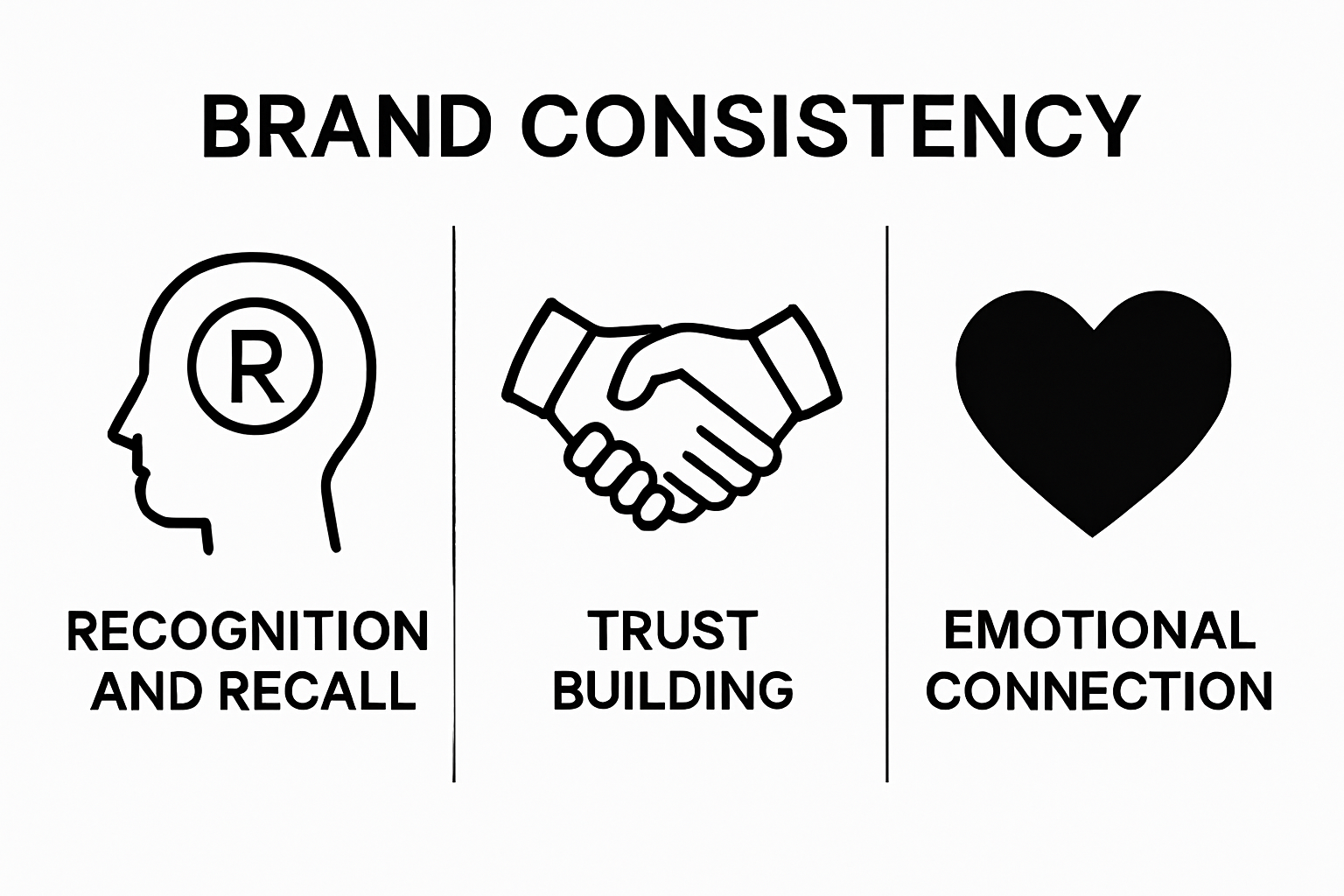Consistent branding sounds simple on the surface. Most people think it just means using the same logo and colours again and again. But research shows something much deeper. Brands with high consistency can grow their revenue by 10% or more. The real magic comes in how a consistent identity shapes trust and long-term loyalty in ways most businesses completely overlook.
Table of Contents
- What Is Consistent Branding And Its Elements?
- Why Does Consistent Branding Matter For Businesses?
- How Consistent Branding Influences Customer Perception
- Key Concepts Of Effective Branding Consistency
- Real-World Examples Of Successful Branding Consistency
Quick Summary
| Takeaway | Explanation |
|---|---|
| Consistent branding enhances recognition | A uniform brand identity builds immediate customer recognition across various platforms and touchpoints. |
| Trust is built through brand uniformity | Consistent messaging and visuals signal reliability, fostering trust in consumers. |
| Emotional connections drive loyalty | A coherent brand experience creates psychological comfort, leading to deeper engagement and loyalty. |
| Alignment across teams is critical | Successful branding requires collaboration among marketing, design, and customer experience teams to maintain brand consistency. |
| Guidelines promote cohesive branding | Developing detailed brand guidelines helps ensure all communications reflect the brand’s core identity and strategic goals. |
What is Consistent Branding and Its Elements?
Consistent branding represents the strategic approach of presenting a unified and coherent identity across all business communication channels and touchpoints. At its core, it involves creating a recognizable and trustworthy brand presence that resonates with target audiences through synchronized visual, verbal, and experiential elements.
The Core Components of Consistent Branding
Consistent branding comprises several critical elements that work together to create a powerful and memorable brand identity. According to research in SAGE Open, these elements include:
- Visual Identity: The visual representation of your brand, including logos, color schemes, typography, and design aesthetics
- Messaging Tone: A uniform communication style that reflects your brand’s personality and values
- Customer Experience: Ensuring interactions align with brand promises across all platforms
Why Consistency Matters in Branding
Brands that maintain consistency generate significant advantages in market perception and customer recognition. When consumers encounter a uniform brand experience, they develop stronger psychological connections and increased trust. This consistency signals professionalism and reliability, distinguishing businesses in competitive markets.
Consistent branding transforms scattered marketing efforts into a cohesive narrative. By presenting a unified front, businesses create memorable impressions that help customers quickly identify and relate to their brand. Whether through a website, social media, printed materials, or customer service interactions, every touchpoint becomes an opportunity to reinforce brand identity.
The psychological impact of consistent branding cannot be overstated. When customers see consistent visual elements, messaging, and experiences, they subconsciously build a more robust and positive perception of the brand. This familiarity breeds comfort and ultimately drives customer loyalty and engagement.
Below is a summary table outlining the core components of consistent branding and how each contributes to a unified brand identity.
| Component | Description | Role in Consistent Branding |
|---|---|---|
| Visual Identity | Logos, colour schemes, typography, design aesthetics | Delivers instant recognition and memorability |
| Messaging Tone | Uniform language, style, and communication reflecting brand values | Builds trust and reinforces brand personality |
| Customer Experience | Aligned interactions across all touchpoints | Ensures brand promises are met consistently |
| Emotional Resonance | Predictable brand experiences fostering psychological comfort | Drives deeper engagement and customer loyalty |
| Strategic Alignment | Communications that reflect core brand values and objectives | Keeps all branding efforts focused and coherent |
Successful consistent branding requires meticulous planning, ongoing commitment, and a holistic approach to brand management. It demands collaboration across marketing, design, and customer experience teams to ensure every aspect of brand communication remains aligned with core brand values and strategic objectives.
Why Does Consistent Branding Matter for Businesses?
Consistent branding serves as a critical strategic asset that transforms how businesses communicate, connect, and compete in increasingly crowded marketplaces. By creating a uniform brand experience, organizations can significantly enhance their market positioning and customer perception.
The Economic Impact of Brand Consistency
According to research from West Virginia University, brands with high consistency are likely to see revenue growth of 10% or more. This substantial economic benefit stems from building a recognizable and trustworthy brand identity that resonates with consumers.

Businesses achieve this through several key mechanisms:
- Recognition and Recall: Customers can instantly identify the brand across different platforms
- Trust Building: Consistent messaging signals professionalism and reliability
- Emotional Connection: Uniform brand experiences create deeper psychological engagement
Psychological Dimensions of Brand Consistency
Beyond financial metrics, consistent branding operates on profound psychological principles. When customers encounter a predictable and coherent brand experience, they develop a sense of comfort and familiarity. This psychological safety translates into increased loyalty, reduced purchase hesitation, and a stronger likelihood of recommending the brand to others.
The emotional landscape of branding goes far beyond visual aesthetics. It encompasses the entire customer journey, from initial awareness to post-purchase interactions. Explore our guide on building a marketing strategy to understand how consistent branding integrates into broader marketing approaches.
Businesses that neglect brand consistency risk fragmenting their market identity. Inconsistent messaging, varying visual styles, and misaligned communication can confuse potential customers, diminishing brand credibility and reducing the effectiveness of marketing investments.
ultimately, consistent branding is not a luxury but a strategic necessity. It transforms scattered marketing efforts into a powerful, cohesive narrative that speaks directly to target audiences, builds lasting relationships, and drives sustainable business growth.
How Consistent Branding Influences Customer Perception
Customer perception represents a complex psychological process where individuals form mental images and emotional associations with a brand based on their cumulative experiences and interactions. Consistent branding plays a pivotal role in strategically shaping these perceptions, creating predictable and reliable brand narratives that resonate deeply with target audiences.
The Psychological Foundations of Brand Perception
According to research on brand consistency, customers develop mental shortcuts when encountering consistent brand experiences. These cognitive patterns help them quickly assess and categorize brands, transforming abstract marketing messages into tangible emotional connections.
Key psychological mechanisms driving brand perception include:
- Pattern Recognition: Humans naturally seek familiar and predictable patterns
- Cognitive Ease: Consistent branding reduces mental processing effort
- Emotional Resonance: Uniform experiences create deeper psychological connections
Trust and Credibility Through Visual and Verbal Alignment
Consistent branding serves as a powerful trust-building mechanism. When visual elements, messaging tone, and customer interactions remain synchronized, businesses signal professionalism and reliability. This alignment transforms random touchpoints into a coherent brand story that customers can understand, relate to, and ultimately trust.
Learn more about digital marketing strategies that can help reinforce your brand’s consistent narrative across different channels. By understanding how different marketing approaches integrate, businesses can create more holistic and compelling brand experiences.
The table below compares the psychological mechanisms of brand consistency with the related customer responses to provide a clearer understanding of how consistent branding shapes perception.
| Psychological Mechanism | Description | Customer Response |
|---|---|---|
| Pattern Recognition | Customers seek out familiar and predictable branding elements | Faster brand identification |
| Cognitive Ease | Consistency reduces the mental effort required to process messages | More positive feelings towards brand |
| Emotional Resonance | Uniformity fosters deeper psychological connections | Increased loyalty and repeat business |
| Trust Building | Aligned visuals and messaging signal professionalism and reliability | Customers develop trust and confidence |
| Comfort/Familiarity | Predictable brand experiences create a sense of safety | Greater engagement and recommendation |
Customers unconsciously evaluate brands through multiple sensory and emotional filters. A misaligned logo, an inconsistent communication style, or conflicting brand messages can trigger cognitive dissonance, making customers feel uncertain and potentially undermining their trust.
The strategic management of brand perception requires continuous attention, deliberate planning, and a commitment to maintaining a unified brand identity. By understanding the intricate psychological mechanisms that drive customer perception, businesses can craft more intentional, resonant, and memorable brand experiences that stand out in competitive marketplaces.
Key Concepts of Effective Branding Consistency
Effective branding consistency is a strategic approach that transcends mere visual repetition, encompassing a holistic framework of communication, design, and experiential elements. It represents a comprehensive methodology for creating a unified and powerful brand identity that resonates across multiple platforms and customer interactions.
Foundational Elements of Brand Consistency
According to research from the University of Nevada, Reno, consistent branding involves maintaining uniform visuals, tone, language, and logos across all platforms. These critical components work together to establish a recognizable and trustworthy brand presence.
The fundamental elements of effective branding consistency include:
- Visual Identity: Uniform design language across all brand materials
- Communication Tone: Consistent messaging style and brand voice
- Emotional Resonance: Creating predictable and reliable brand experiences
- Strategic Alignment: Ensuring all brand communications reflect core values
Strategic Implementation of Brand Consistency
Implementing brand consistency requires a methodical and intentional approach. Businesses must develop comprehensive brand guidelines that serve as a strategic roadmap for all communication and design efforts. Discover more about digital marketing strategies that can help refine your brand’s consistent narrative.
These guidelines should comprehensively address critical aspects such as color palettes, typography, imagery styles, communication protocols, and overarching brand personality. By establishing clear, detailed standards, organizations can ensure that every team member and external partner understands and can replicate the brand’s unique identity.
The most successful brands recognize that consistency is not about rigid conformity but about creating a flexible framework that allows for creative expression while maintaining a recognizable core identity. This nuanced approach enables businesses to adapt to changing market conditions and evolving customer preferences without losing their fundamental brand essence.
Ultimately, effective branding consistency is a dynamic process of continuous alignment, requiring ongoing commitment, strategic thinking, and a deep understanding of how various brand elements interact to create a compelling and memorable brand experience.
Real-World Examples of Successful Branding Consistency
Successful branding consistency represents a strategic art form where businesses create enduring, recognizable identities that transcend individual marketing campaigns. These brands masterfully blend visual, emotional, and communicative elements to construct powerful, memorable narratives that resonate with global audiences.
Global Brand Consistency Champions
According to research from Strathmore University Business School, some brands have achieved extraordinary levels of consistency that transform them from mere companies into cultural icons. Coca-Cola exemplifies this principle, maintaining its distinctive red logo and elegant cursive font for over 130 years, creating an instantly recognizable global brand identity.
Key characteristics of these consistently successful brands include:
- Visual Stability: Unchanging core design elements
- Emotional Coherence: Consistent messaging that reinforces brand values
- Global Recognition: Ability to maintain identity across diverse markets
- Adaptive Flexibility: Subtle evolution without losing core brand essence
Strategic Consistency in Different Industries
Different industries demonstrate unique approaches to maintaining brand consistency. Technology companies like Apple have built their entire brand strategy around minimalist design, clean interfaces, and a promise of innovation that remains consistent across product lines. Explore digital marketing strategies to understand how brands create these powerful narratives.
Consumer brands such as Nike have developed a remarkable consistency in their motivational messaging, always emphasizing performance, determination, and personal achievement. Their communication style remains uniform whether addressing professional athletes or casual consumers, creating a powerful and consistent brand voice.
Financial institutions and professional services firms often use consistency to build trust. By maintaining uniform color schemes, typography, and communication styles across all platforms, they signal reliability and professionalism. This strategic approach transforms branding from a visual exercise into a trust-building mechanism.

These real-world examples demonstrate that successful branding consistency is not about rigid adherence to rules, but about creating a flexible yet recognizable identity that can adapt to changing market dynamics while preserving its fundamental emotional and visual core.
Ready to Make Your Brand Instantly Recognisable?
Reading about consistent branding, you have seen how businesses risk confusion and lost trust when their identity feels scattered. If you want to avoid those common pitfalls and make sure your brand always sends the right message, it is time to partner with experts who understand the emotional and financial value of a unified brand experience. At Zoo Digital, we specialise in aligning your digital presence across every touchpoint. From web development and SEO solutions to data-driven ad campaigns, our tailored strategies help create the dependable and memorable identity customers love.

Stop letting inconsistent branding get in the way of your business growth. Visit our main site here and see how our digital marketing team can help you build the consistent brand recognition that sets you apart. Take the next step now toward a powerful and cohesive partner for your business identity.
Frequently Asked Questions
What is consistent branding?
Consistent branding refers to the strategic approach of presenting a unified and coherent identity across all business communication channels, including visual elements, messaging tone, and customer experiences.
Why is consistent branding important for businesses?
Consistent branding helps enhance market positioning, builds trust with consumers, and creates memorable brand experiences, leading to increased customer loyalty and revenue growth.
How does consistent branding impact customer perception?
Consistent branding influences customer perception by creating familiarity and emotional connections, making customers more likely to trust and engage with the brand.
What are the essential elements of effective branding consistency?
The essential elements include visual identity, communication tone, emotional resonance, and strategic alignment across all branding and marketing channels.
Recommended
- How to Build a Marketing Strategy for Small Businesses in 2025 – Zoo Digital
- Digital Marketing Terms Explained for Small Businesses 2025 – Zoo Digital
- Digital Marketing for Beginners: 2025 Guide for Small Businesses – Zoo Digital
- How to Start Online Advertising: Guide for Small Businesses 2025 – Zoo Digital

